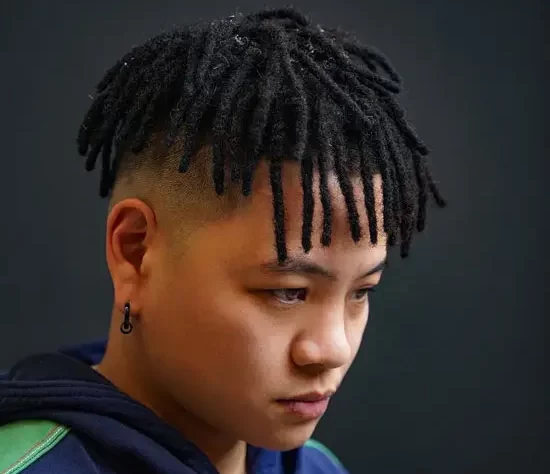
Around the world, dreadlocks have become more and more fashionable in many civilizations, especially dreadlocks on Asian hair. Despite common misunderstandings regarding hair structure, Asian hair can indeed create gorgeous and healthy dreadlocks. Let’s examine how to get and preserve them as we delve into this distinctive style statement.
Understanding Asian Hair Texture
Asian hair is distinct in texture since it is thick, smooth, resilient, straight, and mostly dark in color. Its smoother, sleeker appearance is caused by its rounder follicles, which lack natural curls or waves. Asian hair appears larger and more voluminous due to its thickness. Because of its flatter cuticle, which gives it a smooth, silky texture, it resists frizz and tangling but can be challenging to retain certain hairstyles. Its resilience is due to strong bonds between protein molecules, but can also cause dryness or brittleness if not cared for properly. Asian hair usually varies in color from dark brown to black, depending on sun exposure and heredity. People who embrace and comprehend these distinctive qualities can cherish their natural hair and experiment with different styling alternatives.
Dreadlocks on Asian Hair
In Asian communities, dreadlocks are an important cultural symbol that stands for resistance, spirituality, and uniqueness. They celebrate uniqueness, act as a vehicle for personal expression, and dispel prejudices. Myths and false beliefs around cultural appropriation and hair texture, however, continue to exist. It’s critical to dispel these misconceptions, celebrate diversity, and encourage a broader appreciation for a range of hair types and styles among Asians.
Why Dreadlocks Are Possible on Asian Hair
Asian hair is usually straight, but because of its flexibility and tendency to tangle and knot, it can be made into dreadlocks. Many styles, such as crochet hooking, twist and rip, and backcombing, can be modified to fit the distinct features of Asian hair. Maintaining and caring for hair regularly might help the strands to progressively entwine and lock into fully formed dreadlocks. Asian hair locking can also be facilitated by specialized hair treatments including locking gels, moisturizing oils, and residue-free shampoos. It’s crucial to understand that people, even those from the same ethnic group, might have very different hair textures. With the correct methods, upkeep, and perseverance, Asian hair may achieve and maintain dreadlocks despite certain particular hurdles. People can express their individuality and cultural identity by realizing and appreciating the inherent versatility of Asian hair.
Techniques For Dreadlocking Asian Hair
Here’s a breakdown of the most common techniques for dreadlocking Asian hair, along with considerations for different hair types:
Backcombing
Backcombing hair towards the scalp creates knots and tangles, forming dreadlocks. it is ideal for fine, straighter Asian hair and it helps create initial matting. It also requires patience and may be uncomfortable at first.
Twist and Rip
Dreadlocks are created by twisting hair into sections and ripping them apart, creating knots. it is ideal for wavy or slightly textured Asian hair, this method works well with curling and is easier to do yourself than backcombing.
Crotchet Method
A crochet hook is used to gently pull hairs into existing dreadlocks, tightening and shaping them. This method is suitable for all Asian hair types, especially those with existing locs, and is recommended by a professional loctician for optimal results.
Natural or Neglect Method
This method involves minimal manipulation, allowing hair to naturally lock and form dreads over time through strategic sectioning, particularly suitable for highly textured or curly Asian hair that mats easily but requires patience.
Maintenance and Care For Dreadlocks on Asian Hair
Dreadlocks on Asian hair must be properly maintained and cared for to remain healthy and presentable. An essential part of maintaining dreadlocks is routinely cleaning with residue-free shampoos, massaging the scalp, and rolling your palms to promote locking. To avoid breaking and preserving the integrity of the dreadlocks, Asian hair may also need special care.
Starting and maintaining dreadlocks is a journey of patience and self-discovery. Whether you choose a professional or DIY path, embrace the process and enjoy watching your hair transform into a unique and stunning expression of yourself.
Frequently Asked Questions and Answers About Dreadlocks on Asian Hair
1. Can Asian hair form dreadlocks?
Yes, Asian hair can form dreadlocks, although it may require different techniques and approaches compared to other hair types. While Asian hair is typically straight and smooth, with proper care and maintenance, it can lock and form into dreadlocks over time.
2. What methods are used to create dreadlocks on Asian hair?
Various methods can be used to create dreadlocks on Asian hair, including backcombing, twist and rip, and crochet hooking. These techniques encourage the hair to knot and tangle, gradually forming into dreadlocks with consistent maintenance and manipulation.
3. How long does it take for dreadlocks to form on Asian hair?
The time it takes for dreadlocks to form on Asian hair can vary depending on factors such as hair length, texture, and the chosen method of dreadlock creation. In general, it may take several months to a year or more for fully matured dreadlocks to develop.
4. How do you maintain dreadlocks on Asian hair?
Proper maintenance is essential for keeping dreadlocks on Asian hair healthy and looking their best. This includes regular washing with residue-free shampoos, palm rolling to encourage locking, and moisturizing the scalp to prevent dryness and irritation.
5. Can Asian hair handle the weight of dreadlocks?
While Asian hair may be thicker and more resilient compared to other hair types, the weight of dreadlocks can still pose a challenge, especially as they grow longer and thicker over time. Proper care and support, such as wearing hair ties or using lightweight products, can help alleviate strain on the hair follicles.
6. Are there cultural considerations when wearing dreadlocks as an Asian individual?
Dreadlocks hold cultural significance in various communities, and it’s essential for individuals, including Asians, to be mindful and respectful of these cultural associations. While dreadlocks can be a form of personal expression, it’s crucial to understand and appreciate their roots in different cultures.
7. Can Asian hair revert to its natural state after having dreadlocks?
Yes, Asian hair can revert to its natural state after having dreadlocks, although the process may take time and require patience. Regular maintenance, trimming, and conditioning can help restore the hair’s natural texture and health over time.
Conclusion
Asian hairstyles with dreadlocks combine personal style, cultural expression, and individual individuality. Asian hair may provide special difficulties when it comes to making and keeping dreadlocks, but it is doable with the correct methods, attention, and cultural awareness. People can boldly express themselves through this classic haircut by knowing the method and appreciating the variety of Asian hair.

Leave a Reply